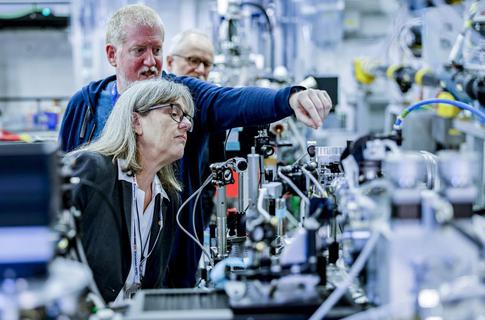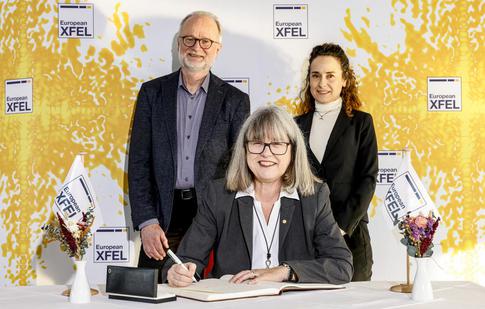XFEL: Nobel Prize winner Donna Strickland visits European XFEL
Nobel Prize winner Donna Strickland visits European XFEL
Donna Strickland, the winner of the 2018 Nobel Prize in Physics, visited European XFEL on Friday. After a scientific exchange with the European XFEL management and scientists, she took part in a guided tour of the experiment hall, and gave a lecture about her prize-winning research.
“Professor Strickland’s research has had a tremendous impact on laser science, which resounds across the scientific community and across society, but has special significance to us at European XFEL,” says Robert Feidenhans’l, managing director of European XFEL.
She also sat down to talk with European XFEL PhD students working at the company.
“It’s inspiring to meet someone who received physics’ highest honour, especially when that person works in a field that’s familiar to you,” says European XFEL PhD student Sharmistha Paul Dutta. “But it’s also a bit intimidating to hear that she won the Nobel Prize for work she did in part during her PhD.”
Strickland received the Nobel Prize in 2018 jointly with Gérard Mourou "for their method of generating high-intensity, ultra-short optical pulses" through a technique known as chirped pulse amplification (CPA). It is hard to amplify very short laser pulses because they deliver a huge amount of energy in a very short time, which can cause catastrophic damage to laser amplifier systems. CPA is a technique that takes ultrashort laser pulses and stretches them into longer pulses before amplifying them, and then recompresses them into short pulses after amplification. This allows for the generation of ultrashort, high-intensity laser pulses. The technique has revolutionised the field of laser optics, enabling numerous applications including corrective eye surgery.

Donna Strickland with FXE leading scientist Chris Milne
Research at European XFEL operates lasers at visible and infrared wavelengths alongside its powerful X-ray beam. These lasers for instance trigger processes in biological proteins or enable spectroscopic measurements. Strickland visited the powerful lasers provided by the Helmholtz International Beamline for Extreme Fields (HIBEF), an international consortium under the leadership of the Helmholtz-Zentrum Dresden-Rossendorf (HZDR) in cooperation with the Hamburg research Centre DESY. The lasers are used at the European XFEL experimental station HED, which provides insights into the structure of materials and into the ultrafast natural processes of plasmas. With these findings, researchers can, for example, improve models of complex physical processes such as planet formation.

Donna Strickland signing the European XFEL guestbook alongside Robert Feidenhans'l, managing director of European XFEL, and scientific director Sakura Pascarelli
“European XFEL is a very impressive research institute,” says Strickland. “I look forward to seeing the results of the research enabled by their high intensity X-ray pulses.”
Read more about the HED instrument and HIBEF: https://www.xfel.eu/facility/instruments/hed/index_eng.html
Press Contact
Dr. Bernd Ebeling
Tel: +49-40-8998-6921
E-mail: bernd.ebeling@xfel.eu
